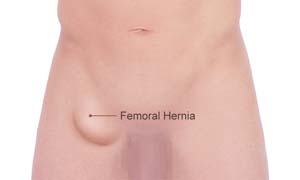Femoral Hernia

What is a Hernia?
A hernia occurs when the internal organs of the abdominal cavity push through a weakened spot in the abdominal wall to form a bulge. Hernias occur most commonly between the area of your rib cage and groin
What is a Femoral Hernia?
A femoral hernia develops just below the lower abdomen and upper thigh, near the groin crease or skin folds around the vagina. The bulge pushes into the femoral canal through which nerves and blood vessels run into the thigh region. Femoral hernias are uncommon and mostly seen in women
Symptoms of Femoral Hernia
Hernias generally do not cause any symptoms but may be discovered on a routine medical exam. Symptoms may include pain, aching, discomfort, or a heaviness in the groin. The bulge formed is more prominent when you stand, cough or strain, and may disappear while lying down as it slips back into the abdomen.
Complications Associated with Femoral Hernia
Treatment of Femoral Hernia
Small hernias that do not cause any symptoms are usually not treated but instead your doctor may follow a wait-and-watch approach.
Surgery is recommended for hernias that show symptoms, are enlarged or entrapped. Surgery may involve an open hernia repair with a larger incision or laparoscopic surgery, a minimally invasive approach with smaller incisions.
Hernias are repaired surgically by closing the defect and using mesh to strengthen the weakened area.
Laparoscopic Femoral Hernia Repair
Laparoscopic hernia repair is performed under general anaesthesia. Your surgeon will make a few small incisions in your groin through which a thin tube called a laparoscope and other special instruments are inserted. A video camera attached to the laparoscope sends magnified images to a monitor guiding your surgeon throughout the procedure. Your surgeon will push the bulge back into the abdomen and either stitch the abdominal wall or use a mesh to support the weakened wall.
Recovery After Femoral Hernia Surgery
Laparoscopic repair is usually performed as an outpatient procedure, so you will return home as soon as you recover from anaesthesia. You may have some swelling or bruising at the incision sites which is normal. Pain and swelling are mostly controlled with medications. It is important to avoid strenuous activity or heavy lifting for at least 2 weeks after the procedure.
Risks and complications Associated with Femoral Hernia Repair
As with any surgery, complications may occur. Complications related to laparoscopic hernia repair include:
- Groin pain due to nerve injury
- Infection at the incision site or mesh
- Blood or fluid accumulation
- Urinary retention
